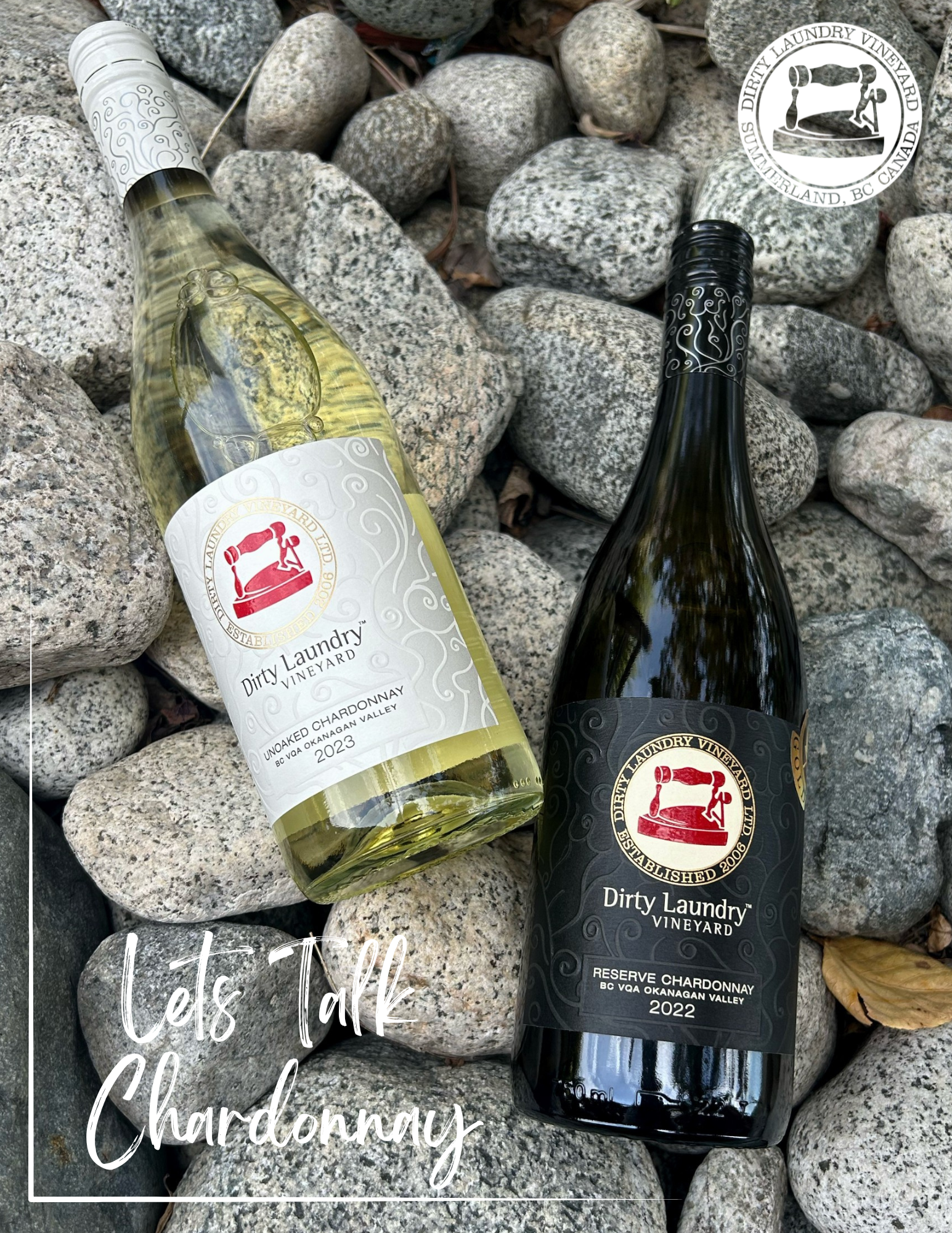Let’s Talk Chardonnay: What are the Differences Between Oaked and Unoaked Chardonnay?

Chardonnay is one of the most popular and versatile white wine grape varieties in the world with an estimated 210,000 hectares (about 518,000 acres) dedicated to Chardonnay cultivation. It is grown in nearly every wine-producing region, from France and Italy to New Zealand and South Africa, and even right here in the Okanagan Valley of BC. Overall, Chardonnay is the fifth most planted wine grape variety globally and the most widely planted white wine grape, due largely to the fact that Chardonnay grapes are easily grown in a wide variety of different climates and soils.
Chardonnay wine can be made using different techniques and can be made in many styles, including still,
sparkling, and even dessert wines, showcasing its adaptability as a grape variety and making it a favourite among winemakers and wine enthusiasts alike.
One of the most significant distinctions in terms of Chardonnay wine-making techniques is between
oaked and
unoaked versions.
The Influence of Oak on Chardonnay Wine
Oak aging is a traditional method used in winemaking to enhance the complexity and depth of a wine. When Chardonnay wine is aged in oak barrels, it undergoes several chemical changes that significantly affect its flavour, aroma, and texture.
For oaked Chardonnay, the choice of oak barrels is crucial. French oak barrels are known for their subtle and elegant influence, imparting delicate spice and vanilla notes. American oak tends to be more robust, contributing stronger flavours of vanilla and coconut.
The size of the barrels and the duration of aging also play a role in the final product. Smaller barrels expose more of the wine to the oak, resulting in a more intense flavour, while larger barrels provide a more restrained oak influence.
In addition to oak aging, the winemaker may choose to induce malolactic fermentation (MLF) in oaked Chardonnay, further enhancing its creamy texture and buttery flavours. Malic acid is a naturally occurring acid in grapes that has a sharp, green apple-like taste. During MLF, malic acid is converted into lactic acid, which is softer and creamier in taste, similar to the acid found in milk. This conversion reduces the overall acidity of the wine and can lead to a smoother mouthfeel.
Some winemakers also employ techniques like lees stirring, where the wine is stirred during aging to incorporate the spent yeast cells (lees) into the wine, adding richness and complexity.
Oaked Chardonnay wine is generally richer, fuller-bodied, and more complex than its unoaked counterpart. This style of Chardonnay often exhibits flavours of ripe tropical fruits like pineapple and mango, along with notes of buttered popcorn, toasted almonds, and a hint of smokiness from the oak. The longer the wine spends in oak, the more pronounced these characteristics become.
The Freshness of Unoaked Chardonnay
In contrast, unoaked Chardonnay is a more recent style (gaining popularity in the 1980s and 1990s as a response to the growing demand for a fresher, more fruit-forward style of Chardonnay) that emphasizes preserving the fresh, fruity character of the Chardonnay grape without the influence of oak. Unoaked Chardonnay wine is typically fermented and aged in stainless steel tanks or neutral oak barrels (barrels which have been used several times and no longer impart significant oak flavours) which allows the natural characteristics of the grape to shine through. The result is a Chardonnay wine that is often described as clean, crisp, and refreshing.
Temperature control is also important in the production of unoaked Chardonnay, as cooler fermentation temperatures help to preserve the wine's bright acidity and crisp fruit flavours.
Common descriptors of unoaked Chardonnay include green apple, lemon, lime, pear, and sometimes subtle notes of stone fruits like peach or apricot. The absence of oak allows the natural acidity of the Chardonnay grape to remain vibrant, giving the wine a zesty and lively mouthfeel.
Unoaked Chardonnay is often compared to other crisp white wines like
Sauvignon Blanc or
Pinot Gris/Pinot Grigio, though it retains its unique identity through the distinctiveness of the Chardonnay grape.
Consumer Preferences and Market Trends
Consumer preference for oaked versus unoaked Chardonnay varies widely, often influenced by regional trends, cultural factors, and individual taste preferences. In the United States, particularly in California, oaked Chardonnay has long been the dominant style, with its rich, full-bodied profile appealing to consumers who enjoy bold and flavourful wines. This style became particularly popular in the 1980s and 1990s, leading to the term "California Chardonnay" often being synonymous with heavily oaked, buttery wines.
However, in recent years, there has been a growing trend towards unoaked Chardonnay, driven by several factors:
Consumers started seeking wines that showcased the natural flavours and a purer expression of the grape rather than the heavy influence of oak.- As consumers became more health-conscious, there was an increasing demand for wines that were perceived as more natural, less manipulated, and lower in alcohol. Unoaked Chardonnays, with their bright acidity and lower alcohol levels, aligned well with these trends.
- Additionally, the lighter, more refreshing unoaked Chardonnay pairs well with a wider variety of foods. This versatility comes from its fresher, lighter profile, higher acidity, and fruit-forward character, which complement a variety of dishes without overwhelming them.
The shift towards a preference for unoaked Chardonnay has been particularly noticeable among younger wine drinkers and those who prefer wines with higher acidity and less overt oak influence. Unoaked Chardonnay has found a strong following in regions like Chablis in France, where the focus is on producing mineral-driven, crisp wines that reflect the terroir of the region.
Food Pairing Considerations
The differences between oaked and unoaked Chardonnay extend to their suitability for food pairings. Oaked Chardonnay, with its rich texture and complex flavours pairs well with dishes that can stand up to its boldness. Creamy pasta dishes, roasted chicken, and dishes with buttery sauces are classic pairings for oaked Chardonnay. The wine's oak-induced smokiness and spice can also complement grilled or smoked foods, as well as dishes with earthy flavours like mushrooms or truffles. The pronounced oak flavors and creamy texture of oaked Chardonnay can, however, clash with lighter, more delicate foods and dishes that have a high acid content such as tomato-based dishes.
Unoaked Chardonnay on the other hand, is more versatile in its food pairings due to its bright acidity and lighter body. It pairs well with seafood, particularly shellfish like oysters, clams, and crab, as well as lighter fish dishes like grilled sole or seared scallops. The crispness of unoaked Chardonnay also makes it a good match for salads, fresh vegetables, and dishes with citrus-based sauces. Its ability to complement a wide range of foods makes unoaked Chardonnay a popular choice for summer dining and outdoor meals.
As with its oaked counterpart, unoaked Chardonnay does have its limitations when it comes to food pairings. It is less-suited to richer dishes, or dishes with a strong flavour profile which would be better balanced by the buttery and oaky characteristics of an oaked Chardonnay.
Conclusion
The choice between oaked and unoaked Chardonnay ultimately comes down to personal preference and the occasion for which the wine is being enjoyed. Oaked Chardonnay offers a rich, complex experience with flavours and textures that can elevate hearty dishes and create a memorable drinking experience. Unoaked Chardonnay, with its clean, crisp character, provides a refreshing alternative that highlights the pure expression of the Chardonnay grape, making it a versatile choice for a variety of foods and settings. Both styles have their merits, and the diversity of Chardonnay as a grape variety ensures that there is a style to suit every palate and a wealth of options for wine lovers to explore and enjoy.

